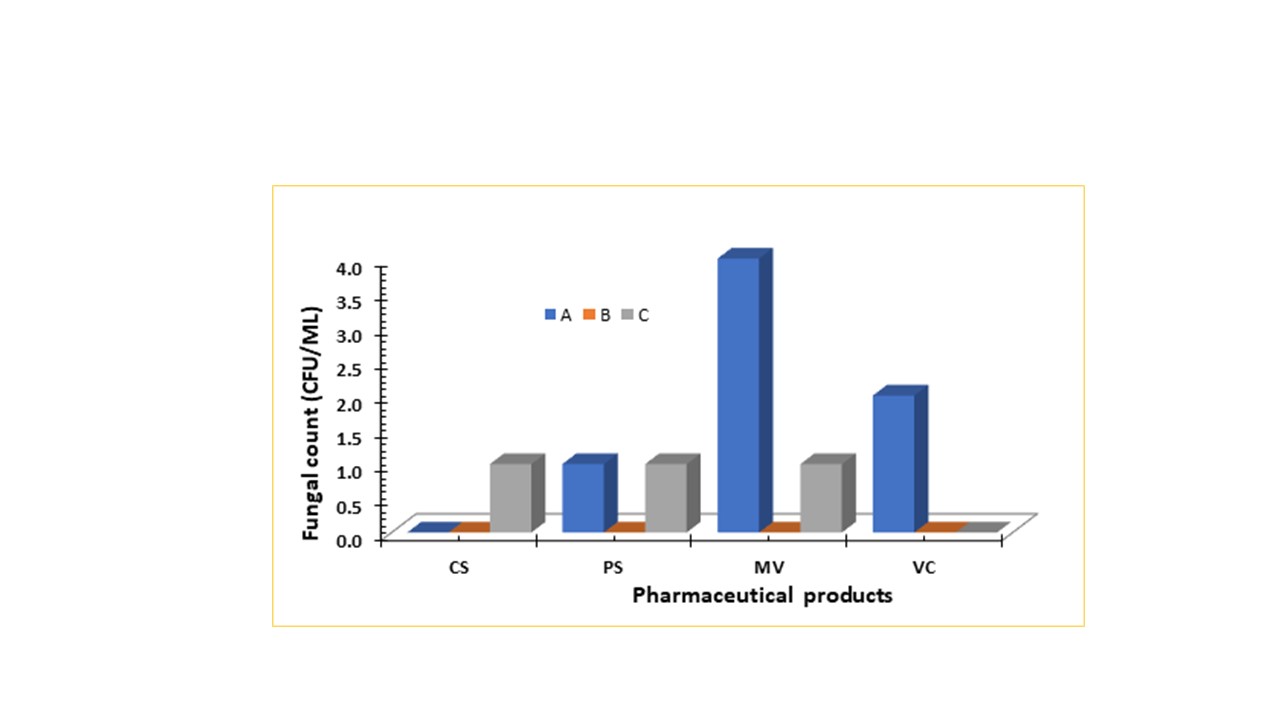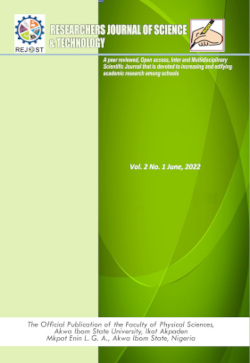Mycotic Quality and Potential Health Implications of Selected Pharmaceutical Syrup Sold in Minna, Niger State, Nigeria
Keywords:
Mycotic quality, Syrup, Contamination, Fungal Load, FungiAbstract
Syrups are liquid medications that contain active ingredients and are ideal for babies, children, and the elderly due to their ease of use. However, their high sugar content and other additives used to enhance taste and stability in syrups make them especially susceptible to microbial growth. This study is aimed at evaluating the mycotic quality of four types of syrup - Vitamin C, Paracetamol, Cough, and Multivitamins sourced from three pharmaceutical stores through spread plate methods. Fungal counts in the samples ranged from 1 x 10¹ to 4 x 10¹ CFU/mL. Mycological analysis identified fungal species including Aspergillus niger, Trichophyton megninii, Penicillium notatum, Aspergillus fumigatus, and Mucorpusillus, with Aspergillus niger and Trichophyton megninii being the most frequently detected followed by mucorpusllus and Peniciliun notatum. The mycotic load met the European Pharmacopoeia's fungal limit of ≤10¹ CFU/mL. The results emphasize the importance of rigorous quality control in pharmaceutical production and storage to prevent microbial contamination and protect patient health. Therefore, it is imperative to promote public awareness campaigns regarding the proper storage of pharmaceutical syrups.
References
Almuzaini, T., & Choonara, I. (2013). Problems associated with substandard and counterfeit medicines in developing countries. British Journal of Clinical Pharmacology, 75(3), 2013.
Awuchi, C. G., Ondari, E. N., Nwozo, S., Odongo, G. A., Eseoghene, I. J., Twinomuhwezi, H., & Okpala, C. O. R. (2022). Mycotoxins’ toxicological mechanisms involving humans, livestock and their associated health concerns: A review. Toxins, 14(3), 167.
Cheesbrough, M. (2006). District Laboratory Practice in Tropical Countries. Cambridge University Press.
Denning, D. W., Pleuvry, A., & Cole, D. C. (2015). Global burden of chronic pulmonary aspergillosis as a sequel to pulmonary tuberculosis. Bulletin of the World Health Organization, 89, 864–872.
Denyer, S. P., Hodges, N. A., & Gorman, S. P. (2011). Hugo and Russell’s Pharmaceutical Microbiology. John Wiley & Sons.
Dinev, T., Velichkova, K., Stoyanova, A., & Sirakov, I. (2023). Microbial Pathogens in Aquaponics Potentially Hazardous for Human Health. Micro-organisms, 11(12), 2824.
Domsch, K. H., Gams, W. (1970). Fungi in agricultural soils, Longman Group Limited, London, pp. 20-152.
Frasz, S. L., & Miller, J. D. (2015). Fungi in Ontario maple syrup & some factors that determine the presence of mold damage. International journal of food microbiology, 207, 66-70.
Frisvad, J. C., Frank, J. M., Houbraken, J. A. M. P., Kuijpers, A. F. A., & Samson, R. A. (2004). New ochratoxin A producing species of Aspergillus section Circumdati. Studies in Mycology, 50, 23–43.
Gao, Y., Qu, M., Song, C., Yin, L., & Zhang, M. (2022). Cerebral vasculitis caused by Talaromycesmarneffei and Aspergillus niger in a HIV-positive patient: A case report and literature review. Journal of Neuro Virology, 1-7
Gurung, K., &Rai, M. K. (2021). Assessment of Microbial qualities of some cough syrups and multivitamins marketed in Pokhara, Nepal. Prithvi Academic Journal, 4, 1-6.
Gupta, A. K., Summerbell, R. C., & Cooper, E. A. (2001). Mycology in dermatology. Journal of the American Academy of Dermatology, 45(5), 764–788.
Haji, M., Kerbache, L., & Al-Ansari, T. (2022). Food quality, drug safety, and increasing public health measures in supply chain management. Processes, 10(9), 1715.
Halls, N. (2016). Contamination of Aqueous-Based Nonsterile Pharmaceuticals. In Microbiological Contamination Control in Pharmaceutical Clean Rooms (pp. 97-126). CRC Press.
Harold, B. (2002). Microbial Application, Laboratory Manual. 8th edition. McGraw-Hill. New York, PP.470-471.
Iacumin, L., Pellegrini, M., Colautti, A., Orecchia, E., & Comi, G. (2022). Microbial Characterization of Retail Cocoa Powders and Chocolate Bars of Five Brands Sold in Italian Supermarkets. Foods, 11(18), 2753.
Imarenezor, E. P. K., Abhadionmhen, O. A., Shinggu, P. P., Briska, J., George, O. S., & Danya, S. (2021). Bacterial contamination of retailed syrups traded in Wukari, North East, Nigeria. International Journal of Biological and Pharmaceutical Sciences Archive, 2021, 02(01), 117–125
Jameel F. (2017) Microbiological Analysis of Marketed Available Cough Syrups in Karachi. RADS J. Biol. Res. Appl. Sci 8(2):5-10.
Kamil, O. H., & Lupuliasa, D. (2011). Modern aspects regarding the microbial spoilage of pharmaceutical products. Farmacia, 59(2), 133-46.
Jazmati, F. N., Trefi, S., Ibrahim, A., & Bitar, Y. (2022). Microbial evaluation of some syrups in Syrian pharmacies. Heliyon, 8(5). 1 – 5.
Lebelo, K., Malebo, N., Mochane, M. J., & Masinde, M. (2021). Chemical contamination pathways and the food safety implications along the various stages of food production: a review. International journal of environmental research and public health, 18(11), 5795.
Martir, J., Flanagan, T., Mann, J., & Fotaki, N. (2017). Recommended strategies for the oral administration of paediatric medicines with food and drinks in the context of their biopharmaceutical properties: a review. Journal of Pharmacy and Pharmacology, 69(4), 384-397.
Meyers, R. S. (2024). The Past, Present, and Future of Oral Dosage Forms for Children. The Journal of Pediatric Pharmacology and Therapeutics, 29(1), 22-31.
Nester, M.T., Anderson, D.G., Robert, C.E. Jr. & Pearsall, N.N. (2002). Microbiology- A Human Perspective. Genitourinary Infections and Antimicrobial Medications. 3rd ed. Madrid, Spain: MacGraw Hill.
Oyebanji, E. O., Adekunle, A. A., Coker, H. A. B., & Adebami, G. E. (2018). Mycotic loads’ determination of non-sterile pharmaceuticals in Lagos state and 16s rdna identification of the fungal isolates. Journal of Applied Pharma-ceutical Research, 6(2), 16-28.
Ratajczak, M., Kubicka, M. M., Kamińska, D., Sawicka, P., & Długaszewska, J. (2015). Microbiological quality of non-sterile pharmaceutical products. Saudi Phar-maceutical Journal, 23(3), 303-307.
Russell, A. D. (2003). Similarities and differences in the responses of microorganisms to biocides. Journal of Antimicrobial Chemotherapy, 52(5), 750-763.
Sandle, T. (2016). Fungal contamination and infection control in pharmaceuticals. American Pharmaceutical Review, 19(1), 56-61.
WHO. (2010). World Health Organization. International Pharmacopoeia, WHO, Technical Report Series, No. 957.

Downloads
Published
How to Cite
Issue
Section
License
Copyright (c) 2024 Researchers Journal of Science and Technology

This work is licensed under a Creative Commons Attribution-NonCommercial-NoDerivatives 4.0 International License.




